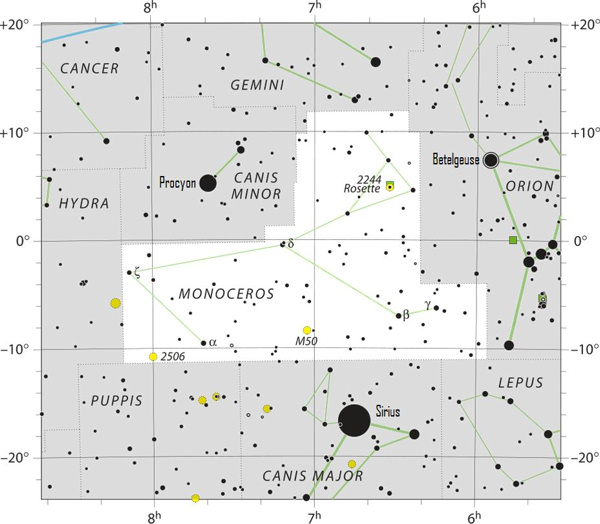
Tonight, treat yourself to a visit with a mythical beast, the constellation Monoceros the Unicorn. It’s well placed for viewing in the January evening sky, but you’ll need a very dark sky to see it. Monoceros will be out nearly all night long. It’ll be higher up and easier to see in the later evening hours.
Let’s find the Unicorn, which comes out at nightfall. Focus in on the bright stars Betelgeuse, Sirius and Procyon (see charts on this page). They make a triangle, which – in the Northern Hemisphere – is sometimes called the Winter Triangle. But these stars can be seen from the Southern Hemisphere, too. In fact, Orion and the stars near it are even better placed for viewing from the southern part of Earth’s globe.
EarthSky lunar calendars are cool! They make great gifts. Order now. Nearly out of stock!
Within the triangle of stars made by Betelgeuse, Sirius and Procyon – hidden between the many bright and glittering stars and constellations visible at this time of year – there’s a constellation that’s as elusive in our night sky as its namesake is in countless fairy tales.
This is the constellation Monoceros the Unicorn. Once again, you will need a very dark sky to see it.

Sky chart of the constellation Monoceros the Unicorn. Click here for a larger chart.

M50 is an open star cluster – a group of stars born from a single cloud of gas and dust in space, still moving together as a family – within the constellation Monoceros the Unicorn. Image via Ole Nielsen/ Wikimedia Commons.
Like all of the night sky, the region of the heavens around Monoceros holds interest. The winter Milky Way runs through here, so it’s a good place to scan with binoculars.
With binoculars, you can see star clusters here. Those with dark skies might try drawing an imaginary line from the star Sirius to Procyon. About a third of the way along this line, you’ll find a hazy object – an open star cluster – called M50.
You need a telescope to see M50 clearly. But, with an ordinary pair of binoculars, this cluster of stars is wonderful to glimpse and contemplate on a winter night. There are really about 100 stars in the little patch we know as M50. The main part of the cluster is about 10 light-years across. The entire cluster is located some 3,000 light-years from us.
Bottom line: Treat yourself to a visit with a mythical beast – Monoceros the Unicorn – in the January evening sky.
Source:
https://earthsky.org/tonight/find-monoceros-the-constellation-of-the-unicorn-within-winter-triangle